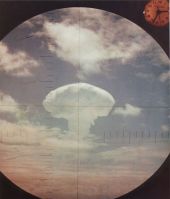Interesting piece by Elbridge Colby (a member of the Pentagon’s New START* negotiation and ratification team) and Paul Lettow (on the National Security Council staff from 2007 to 2009) at the Weekly Standard (again!) defending the nuclear triad of bombers, land-based missiles and sub-launched missiles:
If an opponent figures out how to shoot down stealthy bombers and cruise missiles, we can respond with ballistic missiles. If it figures out how to track submarines, we have ICBMs and bombers. If it tries to take out our land-based forces, we have submarines at sea. The bottom line is that there is no plausible contingency in which an opponent could succeed in frustrating our ability to retaliate. This means there is no reasonable course of action leading to a major attack on the United States.
That’s a costly if. Why is three the magical number? If three is good, isn’t four better? Why isn’t two good enough?
President Reagan launched, along with what he called the Strategic Defense Initiative – SDI, or “Stars Wars” – the so-called Air Defense Initiative, or ADI.
Noted the General Accounting Office (as it was then known), back in 1988:
The purpose of the ADI Program is to develop an air defense system to defend North America against low-observable penetrating bombers and air- and sea-launched cruise missiles.
Things were darn strange back then in the 1980s, according to this article in the Washington Post by Fred Hiatt (now running the paper’s editorial pages):
The Soviets are also likely to develop new cruise missiles that fly through the air, below the reach of SDI’s space weapons. Anticipating such a development, the Air Force is launching a parallel “Air Defense Initiative” (ADI) to shoot down bombers and cruise missiles, said Gen. Robert Herres, U.S. Space Command chief.
“There are no slick panaceas,” Herres said at an industry symposium here, according to Military Space newsletter. “It’s going to cost a lot of money to build an air defense system that is anywhere near leakproof.”
U.S. officials remain confident that, as the Soviets deploy countermeasures, they can invent counter-countermeasures. [Former deputy CIA director] Stevens suggested another possible outcome.
“It is a worrisome possibility that at the end of the SDI adventure . . . the Soviets alone may possess deployed SDI defenses while the United States has abandoned its effort,” he said.
Fretted still-plugging-away-today defense expert Loren Thompson (no relation) in 1984:
The SDI is a long-term effort to define, develop, and deploy a system to defend America against Soviet nuclear attack. The principal SDI emphasis has been on ballistic missile defense, since ICBMs and submarine-launched ballistic missiles appear to represent the most serious challenge to plans for comprehensive population protection. Yet the lack of robust defenses against such air-breathing systems as bombers and cruise missiles could encourage the USSR to alter its present strategic posture away from ballistic missiles to air breathing systems…Ballistic missile defense is a vital component of any nuclear strategy based on moral values, but it is not enough. Air defense is essential. Without air defense, America will never escape the danger into which its own technology has delivered it. With air defense, at least there is basis for hope.
Well, you know how that air-breathing threat turned out…
And while there are elements of ADI still around, the basic concept of shielding the U.S. from all such threats was abandoned as impractical. I’m sure you’ve been worried sick about it ever since.
But the same logic applies to the triad: if we’d begun with a nuclear dyad – bombers and sub-launched missiles, for example – we’d be doing just fine, thank you very much. We’d never have missed those land-based ICBMs. It’s this forward-looking living-in-the-past that seems to hamper the U.S. military – and its think-tank-and-corporate enablers – from the fresh thinking U.S. national security demands.
—
*You just know the next U.S.-Russia arms pact is going to be called the New and Improved START…



